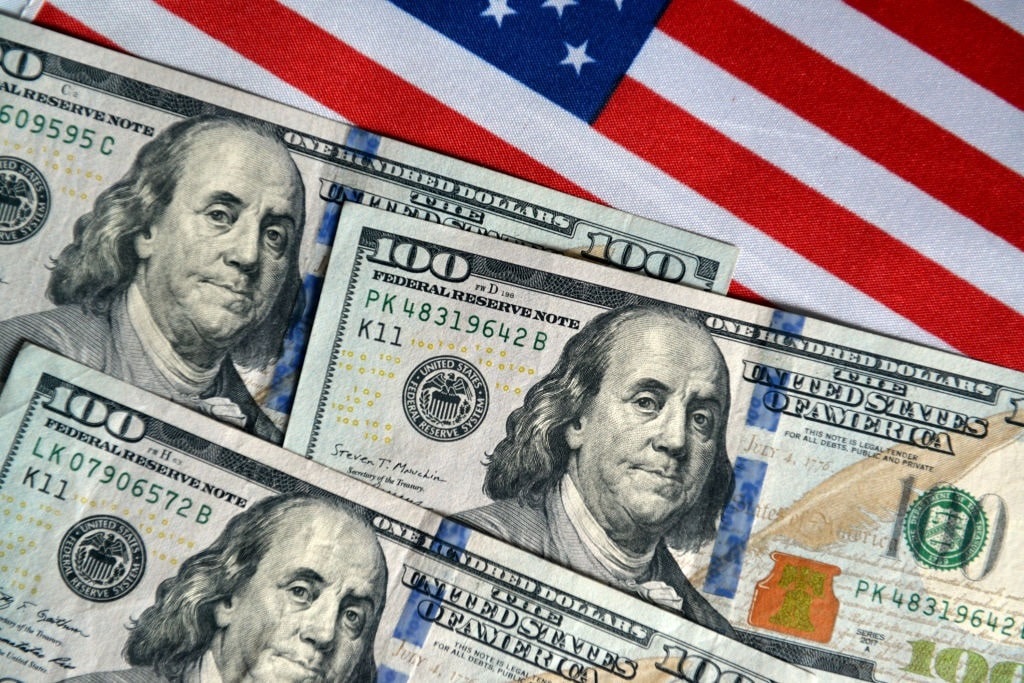



What is a creature that never stops soaring and a burden that keeps on intensifying? Answer: the national debt. It is remarkable how much red ink flooded the corridors of power over the last year, and recent actions by the Treasury Department indicate the gaping holes will never be repaired, except with President Joe Biden’s favorite ice cream. Unfortunately, future generations will bear the brunt of the decadence, excess, and greed of yesterday and today’s breed of Republican and Democratic politicians.
According to the Treasury’s Debt to the Penny dashboard, the national debt is inching closer to the promised land of $34 trillion. It will be an immense milestone for the United States government, meaning the country must pop open a little bit of the bubbly and dance in the shower of IOUs. Remember, statists and Keynesians have long championed the idea that more debt symbolizes wealth!

(Photo by H. Armstrong Roberts/ClassicStock/Getty Images)
But while the nation observes the march toward $34 trillion, taxpayers might need to question how much their share is of the national debt. Don’t fret! We have crunched the numbers.
In 2022, IRS data showed nearly 165 million individual taxpayers. When the national debt is divided by the number of US taxpayers, it becomes clear that each taxpayer owes around $206,000. Or, when calculating on a per-citizen basis, each person’s share is equal to a little more than $100,000.
The likelihood is that this figure will only rise over the coming year as the Treasury is borrowing roughly $6 billion per day. Additionally, the government plans to run cumulative budget deficits of around $17 trillion and pay more than $10 trillion in net interest payments over the next decade. Overall, by the time the world flips the calendar year to 2033, the national debt will be above $43 trillion. This means that if the tax base remains about the same, the per-taxpayer portion of the ocean of red ink will be $260,000.
How is any of this sustainable? Well, the current president is celebrating because he is trimming the shortfall by “over a billion, 300 million, trillion, 300 million dollars.” Astounding, indeed!
Yahoo! Finance published a fascinating article on Christmas Eve titled “5 common misconceptions about the US’s $33 trillion debt mountain.” The author highlighted several so-called falsehoods about “America’s ginormous debt mountain.” The list?
A few components of the piece need to be addressed.
 First, at the bare minimum, Washington must pay down some of the national debt. Why? Interest payments are growing and becoming one of the largest budgetary items for taxpayers, which is essentially tossing finite resources down the tube. If the US government is collecting less revenue and spending more, the deficit will only trend upward, forcing the nation’s capital to make tough choices in annual outlays, including mandatory expenditures.
First, at the bare minimum, Washington must pay down some of the national debt. Why? Interest payments are growing and becoming one of the largest budgetary items for taxpayers, which is essentially tossing finite resources down the tube. If the US government is collecting less revenue and spending more, the deficit will only trend upward, forcing the nation’s capital to make tough choices in annual outlays, including mandatory expenditures.
Also, a debt crisis is inevitable. Maybe not today, maybe not tomorrow, but someday and for the rest of your life. Moody’s Investors Service and Fitch Ratings have sounded the alarm about America’s “fiscal deterioration,” justifying their recent downgrades of the nation’s credit. If these agencies, who are usually optimistic about US fiscal conditions, are furrowing their brows, then maybe there should be a cause for concern.
That said, the article was correct in purporting that US debt challenges are not unique. Much of the world, be it China or the European Union, is experiencing red ink floods. The United States can weather the storm because the US dollar, backed by nothing, is still the international reserve currency, and the public views Treasury securities as good as gold.
A chorus of economists asserts that the country should not lose sleep over the national debt despite the enormous numbers. As long as the gross domestic product is $25 trillion, the US can prevent itself from being sucked into a fiscal black hole. The issue is that the debt-to-GDP ratio is already 120%, shy of the pandemic-era record high of 133%. Typically, according to the Keynesian orthodoxy prevalent in Washington since the Great Depression, the government runs deficits to stimulate the economy during recessions. However, the 21st century has been a time of perpetual budget shortfalls, adding to the ballooning national debt. If the economy is as great as the current administration’s daily ticker-tape parades suggest, what happens if the nation slides into a downturn that the White House and unelected bureaucrats cannot redefine?
